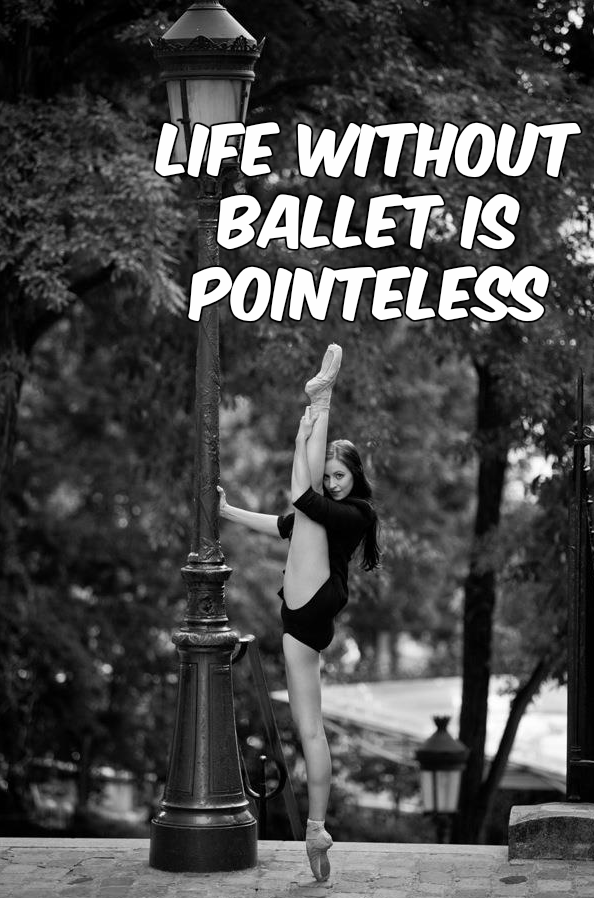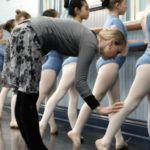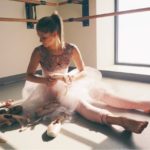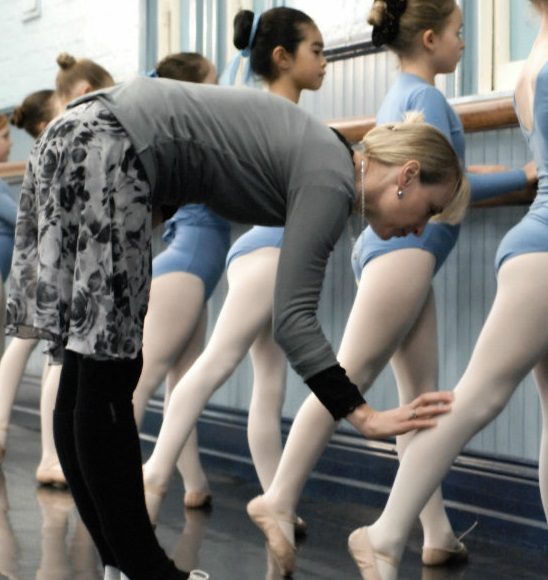Ballet Experts Reveal When You Are Ready For Pointe
As a classically trained dancer, ballet has always been something that I hold close to my heart. As many little ballerinas do, I started out in a small community hall, in my ballet shoes and pink leotard, learning basic steps such as a Plié and Tendu. It wasn’t long before my love for ballet blossomed into a passion of all things dance and it was time to start thinking about preparing myself for my first set of pointe shoes.
As much as I wanted to jump straight into my first pair of Pointe Shoes the decision was not entirely up to me. Inevitably it will be your ballet teacher’s decision to determine when you are ready for Pointe. It is for this reason that I reached out to a number of respected ballet schools, blogger and teacher’s from all over the world to ask them the following question.
“How would you determine as a teacher when it is the right time for one of your students to go on Pointe?”
I would like to thank everyone for their time and participation who have spoken with me on this matter. As you continue reading it is clear that your collaboration has proven extremely informative to say the least.
As a Gold Coast dance school owner I also have my own set of prerequisite criteria that is required in order to be eligible to progress onto pointe in one of my ballet classes. As you will read it is obvious that through all of the responses given to this questions one thing remains constants,” STRENGHTH”. If your strength is not present in all of the key areas before progressing to pointe it can cause injuries. Without further ado let’s find out what the experts have to say.
Kate Reilly – Melbourne School of Classical Dance
 My students going en pointe must pass a pre-pointe assessment with an independent dance physiotherapist. We recommend an initial assessment 3-6 months before the commencement of pointe work – this allows young dancers time to address any areas of weakness through specific exercises and re-visit the physio a few times, if needs be, so that they have the best chance of developing a beautiful and safe pointe technique.
My students going en pointe must pass a pre-pointe assessment with an independent dance physiotherapist. We recommend an initial assessment 3-6 months before the commencement of pointe work – this allows young dancers time to address any areas of weakness through specific exercises and re-visit the physio a few times, if needs be, so that they have the best chance of developing a beautiful and safe pointe technique.
Ashleyanne Hensley – The Georgia Ballet
 We have certain parameters that a student must accomplish on their schedule within our Intermediate 1 level of the School. This level is the group that is under watch for being ready. At the beginning of the year we discuss their requirements and do a “test” with all of them. Then they are informed of the areas they need work on and are tested once a month from there. All the requirements are within their reach within that year, as expected.
We have certain parameters that a student must accomplish on their schedule within our Intermediate 1 level of the School. This level is the group that is under watch for being ready. At the beginning of the year we discuss their requirements and do a “test” with all of them. Then they are informed of the areas they need work on and are tested once a month from there. All the requirements are within their reach within that year, as expected.
One dancer struggled for 7 months to get her plank for 3 minutes. A correct plank. Another is ready for pointe but she is only 10 going on 11 and super tiny. Hasn’t grown much. So holding her until some growth and when she turns 11. Other students take their corrections and have them applied and ready by the next time. So many details in making it happen.
All students have to be able to accomplish 50 releves straight legged in 6th and 1st correctly. No bending of knees, no sitting back in heels, no relaxing of the gluteals. Then their second position releve must be in alignment from hip down to big toe joint. If anything is askew, they are not passed.
I have another student who is so tight in her hamstrings and IT bands that her feet sickle on releve which holds her back immensely. Then their tendu in a la seconde is analyzed for alignment and toe pointing ability. The 3 minute plank is usually what holds everyone up the first time. We have to have them solid in their back and core muscles for going en pointe.
All this, is of course, based upon them being ready to progress to Intermediate 1 which demands correct alignment while standing in 1st, 2nd, and 5th and a working knowledge of vocabulary and basic skills.
Sibylle Acatos-Dadey – Scottsdale School of Ballet
First I don’t put anyone on Pointe before they turn 10 ,then you can tell by the strength in their legs if they can do 3 “piqués ” in a row without bending their leg ,it’s a good start …of course there is more than that ,how do they push and stretch their legs in jumps !
Julie Cronshaw – Highgate Ballet School
 What I did not glean from looking through the contributions was the actual technique used when en pointe! Do you spring up or clamber up? Most schools do not even know about this let alone employ the sprung pointe technique anymore although for decades this was how it was taught globally-and indeed, Vaganova herself quotes in her book that she employed this Method for teaching pointework.
What I did not glean from looking through the contributions was the actual technique used when en pointe! Do you spring up or clamber up? Most schools do not even know about this let alone employ the sprung pointe technique anymore although for decades this was how it was taught globally-and indeed, Vaganova herself quotes in her book that she employed this Method for teaching pointework.
As a Cecchetti Method ballet school we follow the physical and theoretical principles laid down by Maestro Cecchetti more than 100 years ago. This includes an understanding of the correct use of standing in the aplomb (not the more prevalent system of standing on the balls of the feet) which naturally leads to using slight spring technique to be secure en pointe. My students are amateur level so in fairness I cannot comment on how they would fare dancing one hour pointe work a day for example but we have very few issues with basic pointework and even children whom most vocational schools wouldn’t let in through the door let alone on pointe, also can get up on pointe eventually, once they have been assessed as capable of doing so. They have, most importantly, learned how to do relever correctly with a strongly held body and straight legs. No fancy science, Pilates or planks!!! Of course there are children with orthopaedic issues but those issues will have been discovered long before a child goes en pointe-just look at how they move, coordinated or not, and use their feet when they are dancing!
My students tend to go en pointe later than many of your contributors, often they are in their teens, but then they are for the most part, attending only twice a week.
In my opinion (as a teacher who has travelled the world as a professional dancer and teacher and been immersed in several systems including Russian, Balanchine, French and of course the Royal Ballet School’s where I started as a student teacher) the Cecchetti sprung technique is second to none. Safe, secure, simple. This is why I teach it to amateurs – The Italian school invented virtuosic pointework-fouettes, hops en pointe, maneges and so on so even for a non-Cecchetti trained dancer it makes sense to use this method when you are learning these steps. Just look at the fouettes sequence in the film ‘Black Swan’ if you need to know what the sprung technique is, or most vintage (black and white) ballet films on Youtube.
Breanna Dvorak – North Ballet Academy
 The students at North Ballet Academy start pointe in Level 2 in our Complete Classical Ballet Program. In addition to their ballet classes three times per week, we incorporate ankle strengthening exercises in their required Pilates classes (twice per week) and after taking Pre-Pointe classes from September-January they are then evaluated to go on pointe. When evaluating our students as to their readiness to dance en pointe we look at areas such as ankle strength, being able to properly rise up to their releve (demi pointe)- not sickling and evenly distributing their weight, coordination from plie into a releve or jump (pushing and landing on both feet), as well as their age, work ethic, and physical development. Most of our students are between the ages of 9-11 when they first start pointe and are taking technique & pointe classes 3x per week in addition to their Pilates class 2x per week.
The students at North Ballet Academy start pointe in Level 2 in our Complete Classical Ballet Program. In addition to their ballet classes three times per week, we incorporate ankle strengthening exercises in their required Pilates classes (twice per week) and after taking Pre-Pointe classes from September-January they are then evaluated to go on pointe. When evaluating our students as to their readiness to dance en pointe we look at areas such as ankle strength, being able to properly rise up to their releve (demi pointe)- not sickling and evenly distributing their weight, coordination from plie into a releve or jump (pushing and landing on both feet), as well as their age, work ethic, and physical development. Most of our students are between the ages of 9-11 when they first start pointe and are taking technique & pointe classes 3x per week in addition to their Pilates class 2x per week.

Katerina Fedotova – Russian Ballet Orlando
 The best time for dancers to go up on pointe is between ages 9-11. For the first two years is a preparation for pointe where dancers built strength in their feet and legs and learn how to properly stand on pointe. After the first year or two, only then they are ready to do technical combinations on pointe. If you go up later in age, 12 – 14, then you miss those two years of foundations and preparation, which will open you up to injuries, improper balance on pointe and fundamental basics.
The best time for dancers to go up on pointe is between ages 9-11. For the first two years is a preparation for pointe where dancers built strength in their feet and legs and learn how to properly stand on pointe. After the first year or two, only then they are ready to do technical combinations on pointe. If you go up later in age, 12 – 14, then you miss those two years of foundations and preparation, which will open you up to injuries, improper balance on pointe and fundamental basics.
Alison Gibson Snare – The Tasmanian Academy of Dance
 A minimum for four years training to build strength and knowledge advisable. Strong core and understanding of secure posture. The student needs to demonstrate maturity – in that they think before they move. For students lacking flexibility in the ankle joints some work improving flexibility would be advised before starting pointe.
A minimum for four years training to build strength and knowledge advisable. Strong core and understanding of secure posture. The student needs to demonstrate maturity – in that they think before they move. For students lacking flexibility in the ankle joints some work improving flexibility would be advised before starting pointe.
Rob and Chandra – Denver Academy of Ballet
 For us at DAB we have an age requirement of 10 years old, with teacher/parent/doctor all agreeing the child is ready. Some people think it’s a bit much to require a doctors visit, but we feel there are things your child’s doctor knows about their health that we don’t, so we like having their input. From there we do 1-2 years of pre pointe strengthening classes, (picking up marbles with toes, Thera band excercises, core strengthening work) before any child is sent for pointe shoe fittings. There are 5 basic skills we look for them to do before we approve as teachers. Grande plié in 5th position without the barre, balance in passé for 8 counts, rise to pointe in flat shoes and hold for 4 counts, sitting on the floor flex their feet and hold heels off the ground for 30 seconds and 50 full sit-ups without stopping. or whining.. I always say, pointe shoes are like Wands in Harry Potter: the shoe will choose the girl, not the girl will choose the shoe. Everyone is different and no two girls are alike: so be patient, work hard and maintain spectacular focus towards your goals and you will achieve most of them.
For us at DAB we have an age requirement of 10 years old, with teacher/parent/doctor all agreeing the child is ready. Some people think it’s a bit much to require a doctors visit, but we feel there are things your child’s doctor knows about their health that we don’t, so we like having their input. From there we do 1-2 years of pre pointe strengthening classes, (picking up marbles with toes, Thera band excercises, core strengthening work) before any child is sent for pointe shoe fittings. There are 5 basic skills we look for them to do before we approve as teachers. Grande plié in 5th position without the barre, balance in passé for 8 counts, rise to pointe in flat shoes and hold for 4 counts, sitting on the floor flex their feet and hold heels off the ground for 30 seconds and 50 full sit-ups without stopping. or whining.. I always say, pointe shoes are like Wands in Harry Potter: the shoe will choose the girl, not the girl will choose the shoe. Everyone is different and no two girls are alike: so be patient, work hard and maintain spectacular focus towards your goals and you will achieve most of them.
Shayne Davies – Tasmanian Youth Classical Ballet Company
 Safe transition to pointe work is of utmost importance in dance training. We assess our students individually based on technique, strength and growth, and normally they reach the minimum developmental and technical requirements at around the ages of 12 to 13. Once we consider that they are strong enough for pointe we refer them to a physiotherapist specialising in dance for a pointe assessment. This provides a level of individual care and attention that helps to target any technical or alignment faults. Our students and their parents understand that safety and wellbeing of the dancer is our priority and that this means some may need to wait longer than others to wear their first pair of pointe shoes.
Safe transition to pointe work is of utmost importance in dance training. We assess our students individually based on technique, strength and growth, and normally they reach the minimum developmental and technical requirements at around the ages of 12 to 13. Once we consider that they are strong enough for pointe we refer them to a physiotherapist specialising in dance for a pointe assessment. This provides a level of individual care and attention that helps to target any technical or alignment faults. Our students and their parents understand that safety and wellbeing of the dancer is our priority and that this means some may need to wait longer than others to wear their first pair of pointe shoes.
Insider Tip:
The Fit of your first pair of pointe shoes can drastically be affected by the different type of padding you are using. Before your first pointe shoe fitting be sure to ask you teacher what they prefer you to wear.
Kristen (Professional Dancer) – Setting The Barre Blog
 Getting that first pair of pointe shoes is an exciting venture for any young dancer, but even the most seemingly glamorous of endeavors comes with a bit of measure. Due to the highly dangerous nature of placing one’s entire body weight on the tips of the toes, it’s essential that the bones and muscles of a dancer’s foot are developed enough to support this extreme pressure. As a teacher, it is crucial to take care that your students’ have also achieved a superior level of ankle strength in order to avoid injury. In terms of intangible stability, it is also important to be sure each dancer wishing to go “en pointe” is taking their education seriously; Dancing on pointe is an honorable pursuit that requires daily training and unwavering perseverance- even for professionals!
Getting that first pair of pointe shoes is an exciting venture for any young dancer, but even the most seemingly glamorous of endeavors comes with a bit of measure. Due to the highly dangerous nature of placing one’s entire body weight on the tips of the toes, it’s essential that the bones and muscles of a dancer’s foot are developed enough to support this extreme pressure. As a teacher, it is crucial to take care that your students’ have also achieved a superior level of ankle strength in order to avoid injury. In terms of intangible stability, it is also important to be sure each dancer wishing to go “en pointe” is taking their education seriously; Dancing on pointe is an honorable pursuit that requires daily training and unwavering perseverance- even for professionals!
Louise Louise Bracey – Adult Ballet Classes
 I only teach Adults. However, I occasionally I have a student wishing to start or re start Pointe work and I always put them off. This is most likely, because I only compare to the high standards I’m accustomed to from my own experience at The Royal Ballet School.
I only teach Adults. However, I occasionally I have a student wishing to start or re start Pointe work and I always put them off. This is most likely, because I only compare to the high standards I’m accustomed to from my own experience at The Royal Ballet School.
As a child I had very good training from the age of 4 including an RAD scholarship at 10 then being at White Lodge (The Royal Ballet School) at 12.
The main thing is to understand that the whole process is very gradual. Having had grueling professional training for 8 years, only then at the age of 11 or 12 we began some Pointe Work, just one hour per week. This then increases to several hours a day (eventually!) a few years there after!
Sarah Arnold – The Accidental Artist
 We spend one year in a class called “Prepointe” practicing ballet conditioning exercises for the feet. The students are tested periodically for pointe readiness by strength assessments such as relevés on two feet, one foot, stability, stance and adequate flexibility in the ankle and foot. Another good test is the ability to balance a single pirouette en dehors by finishing the turn on a high demi-pointe.
We spend one year in a class called “Prepointe” practicing ballet conditioning exercises for the feet. The students are tested periodically for pointe readiness by strength assessments such as relevés on two feet, one foot, stability, stance and adequate flexibility in the ankle and foot. Another good test is the ability to balance a single pirouette en dehors by finishing the turn on a high demi-pointe.
Kim Hungerford – The Ballet Source Blog
 Pointe work carries some risk of injury, therefore the aspiring student should be carefully evaluated before beginning her pointe training. Starting at the age of 12 is highly recommended for muscle development. The student must attend class faithfully and regularly, with at least two other ballet classes a week besides her pointe class. Her turnout must be strong and equal on both sides, and the student must demonstrate the overall strength, coordination, alignment and muscle tone necessary for this complicated art form.
Pointe work carries some risk of injury, therefore the aspiring student should be carefully evaluated before beginning her pointe training. Starting at the age of 12 is highly recommended for muscle development. The student must attend class faithfully and regularly, with at least two other ballet classes a week besides her pointe class. Her turnout must be strong and equal on both sides, and the student must demonstrate the overall strength, coordination, alignment and muscle tone necessary for this complicated art form.




